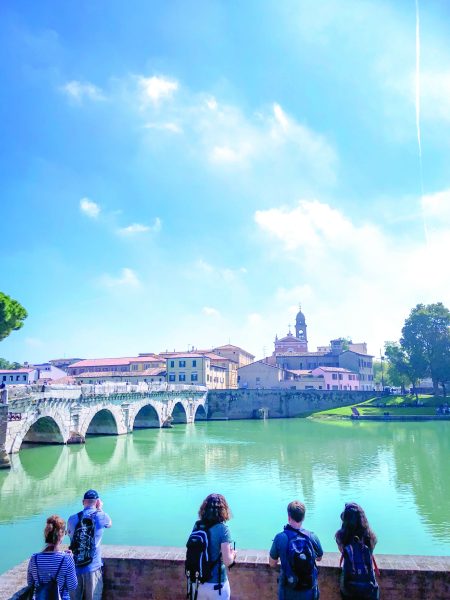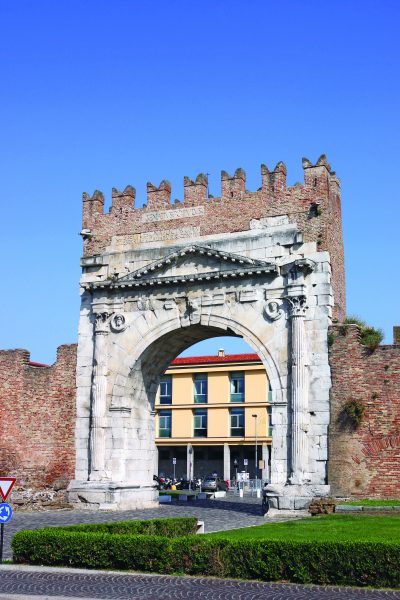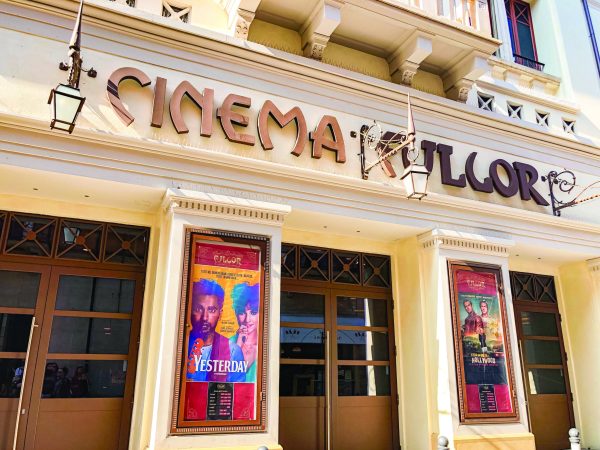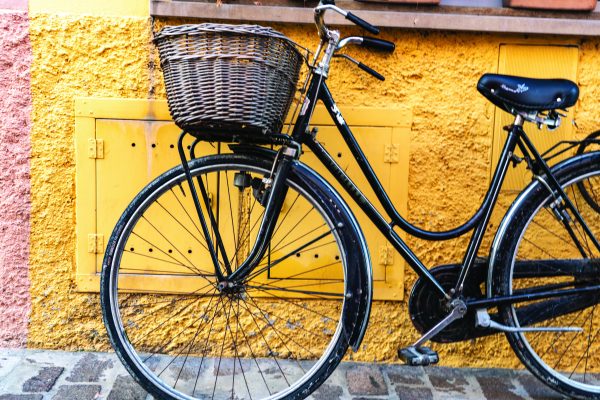There’s so much more to Rimini than just its beaches – the city was founded by the Romans and boasts a full 2,000 years of history. And, of course, it was the place where it all began for Federico Fellini, writes Abigail King
Images by Abigail King unless otherwise stated
It’s Friday night, so it’s cinema night. Amid the flickering lights that dance along the wet street stones, I can hear something. Footsteps, for sure, in heels and black leather, and the carefree laughter that welcomes in the weekend.
But there’s something else here in Rimini, something that follows me into the deep red curtains of the Fulgor Cinema, mingling amid the sweet song of popcorn and the hush of anticipation that settles over the crowd.
Is it too fanciful to imagine that it’s a whisper from the past? “Talking about dreams is like talking about movies. Years can pass in a second, and you can hop from one place to another.”
Those words come from Federico Fellini, the Italian director responsible for La Strada and Nights of Cabiria and perhaps the most famous film about Italy of all time: La Dolce Vita.
Yet this little cinema in a small street in Rimini was where it all began. For this is Fellini’s hometown, and this cinema was where he used to hand out promotional playbills in exchange for free tickets, and spend hours watching story after story unfold. So it made sense to me to start our 48 hours in Rimini right here, and to let the stories of this coastal highlight of Emilia-Romagna unfold over the next couple of days.
The morning after
Our Saturday morning begins, as all good stories do, at the beginning. Or close to it, anyway…
At the Arch of Augustus that stands in the centre of Rimini. Rimini itself was founded by the Romans in 268 BC as a vital communications point between the north and south of the peninsula. The Arch of Augustus arrived a little later, in 27 BC, and remains one of the oldest Roman arches to have survived. It reminds me of a wedding cake and a fairytale castle mixed together, with faded red brick battlements on top. Teetering above the fluted columns and Corinthian capitals stand four shields: Jupiter and Apollo on the side that faces Rome, and Neptune and Roma on side that faces Rimini.
This arch marked the end of the Via Flaminia, which led over the Apennine Mountains from Rome to Rimini, or Ariminum as it was back then. And that’s not the only name change in a city that’s thousands of years old.

From the arch, it’s a quick walk through the Old Town to Piazza Tre Martiri. This beating heart of the centre welcomes solitary bicycles at daybreak and thronging crowds by coffee time. The clocktower glows a sweet orange at sunset, watchful as lamps glimmer and diners flow across the piazza, the centre of which is distinctively marked by cobblestones into a star shape.
It’s a pretty, peaceful place. But that wasn’t always the case, as the naming conventions show. Once, Italians knew this square as Piazza Giulio Cesare, the place where Julius Caesar uttered those immortal words iacta alea esto: let the die be cast.
For it was near here that Caesar and his army crossed the Rubicon, an act of war, and then marched his troops towards Rome. Centuries after this momentous event, the city erected a statue on the piazza and gave the meeting point his name. A few hundred years after that, they changed it to Piazza Tre Martiri. And to understand why they did that, we need to time travel again.
The three martyrs
Now we’re in the embers of the Second World War. Mussolini’s forces have failed and the Allies are pushing up through Italy from the south, but the Nazis still occupy the land of their former allies in the north. Three young Resistance fighters have organised to sabotage a threshing machine near Rimini in a bid to halt the Nazi supply chain. They are caught and executed in this very piazza. Hence the name change, to the Square of the Three Martyrs. All of which is hard to imagine today.
Students throng between the covered walkways, moving with a lightness and restlessness that hasn’t yet faded with age. Cafés spill onto the streets, their tablecloths fluttering like flags beneath expert hands as coffee and sugar-dusted biscuits are served.
But Rimini hasn’t finished with the past just yet. We walk a few more blocks and enter the cool white sanctuary of the Tempio Malatestiano. It’s like walking into a temple dedicated to bleached lavender, with columns and sculptures in cool blue and sweet lilac. It stands as the unfinished cathedral church of Rimini, an homage to St Francis. Yet folklore tells a different story.
During the height of the Renaissance, local magnate Sigismondo Pandolfo Malatesta commissioned reconstruction of the work, hiring Leon Battista Alberti as the architect. The exterior seems a rather plain affair, with blocks of stone and muted adornments and hardly a hint of scandal. But inside, the situation changes.
Naked bodies abound. In sculpture, of course, not in the flesh, but a disproportionate number have their hips set at eye level for visitors. History talks about Malatesta’s excommunication from the Church, the rumours about his lover, and the serious depletion of his funds. As for the Tempio Malatestiano itself, in the words of Pope Pius II, it is “full of pagan gods and profane things.” And it’s worth a visit just for that.
The curtain rises
From the Renaissance, we travel to the late 19th century, and the glamour of the Amintore Galli Theatre, dripping in cream and gold. The theatre reopened its doors in 2018, a full 75 years after they were closed when everything that stood behind them was destroyed by bombing. Standing beneath the russet-coloured columns at the entrance, I try to imagine how the crowds rise and fall through the Piazza Cavour outside.
In the afternoon, we meet a friend at Castel Sismondo. And it’s back to the Renaissance with the infamous Sigismondo Pandolfo Malatesta. Square-edged towers and walls jostle together like overbearing chess pieces at Castel Sismondo on the edge of Rimini’s Old Town. This was the former home of Malatesta, with work beginning in March 1437 and then rumbling and rambling on for a further fifteen years. During this time, several architects became involved, most notably Filippo Brunelleschi, the man known as the world’s first modern engineer.
Over the next few centuries, the external walls were demolished, the moat filled, and then the carabinieri moved in as Sismondo became a barracks in the 1800s. Today the castle hosts international exhibitions and events for local museums.
For the evening, we crossed the crumbling yet chunky stone Bridge of Tiberius to enter Borgo San Giuliano on the other side of the Marecchia River. Once considered the wrong side of the tracks, in the dimming and dipping sunset light, this seafaring community reminds me of Fellini and his sense of magic.
And I’m not the only one. Between the winding passageways of tumbling flowers, peeling paint and creeping ivy, I find murals. Mural after mural of dreamy street art. Not the kind with skulls and death and scrambled, jagged letters, but rather images of fishermen and whales and the kiss of la dolce vita. In pops of turquoise, lemon and tangerine, the crumbling walls bring Italian dreams to life.
They stem from the Festa del Borgo San Giuliano, a festival that began in 1979 and that takes place every two years in September.
Combining music, food, theatre and fireworks, artists would create new murals by painting over the ones that came before.
Then, in 1994, the Borgo chose a Fellini theme, and because the residents loved the artwork so much they changed the tradition. Now the pictures remain, dreamlike and charming, an everlasting vision of the Italy people would like to share. In the trattorie, that vision continues with some of the finest and homeliest foods from Emilia- Romagna.
We dined on homemade piadine, handmade capelletti and the hard Talamello fossa cheese, served with figs and honey. The next morning was a liltingly lazy Sunday in Rimini, and, at last, we arrived at the coast. It’s a short walk, or an even shorter bicycle ride, from the Old Town to the sea, travelling to the Belle Epoque era at the aptly named Grand Hotel.
Palms surround the Art Nouveau façade, while five-star rooms overlook the sea and staff guard the only private beach in Rimini. Inside, waiters glide between 18th-century furniture from France and Venice, and well-dressed guests linger beneath Murano glass chandeliers framed by marble interiors. My film friends tell me they’ve seen this place before, as the background to Fellini’s 1973 picture Amarcord. Italy designated it a national monument in 1994.
Brunch arrives with flair. A rainbow of sliced melon, fresh prawns, white tablecloths, water and wine and the rose-tinted memories of a more decadent era.
Well fed, we while away the afternoon on e-bikes, riding over the gentle hills to Santarcangelo di Romagna. At the start of the journey, I can’t see the point of electronic assistance. By the end, however, I don’t know how I’d ever have managed without it. We have travelled, according to the map, from sea level to the peak of Mount Jupiter, or Monte Giove.
Secret Caves
Once there, we find our old friend Sigismondo Malatesta again. The Malatesta Castle rises high above the rolling green landscape, but our time is spent largely below the ground in the series of secret caves here. The Grotte Tufacee Comunali, as they are called in Italian, link shadows and cobwebs into an intricate network where locals still store their wine. And it’s no ordinary wine.
Sangiovese translates to “the blood of Jupiter”, and it’s a hearty red drink that serves to make the cycle back to Rimini that much more dreamy. But when all is said and done, Rimini’s character is intrinsically linked to the sea. Back on the seafront, we walk past the 1960s boomtown of pretty parasols in baby blue and lemon and onto the narrow boardwalk that leads to our host for the night: a small boat, a chef, and some big dreams.
For tonight, we dine upon the waves. As we feast on sfiziosi e colorati, ravioli di ricotta and zuppa inglese, the small boat skates on the waves, and we watching them turn from blue to autumn to silent black.
Away from the lights of Rimini, it’s easy to look up at the sky. To think about the waxing and waning passages of time and to let our eyes linger on the other kind of stars.
Enjoyed this article? Find out more info about the area in our Rimini archive.

